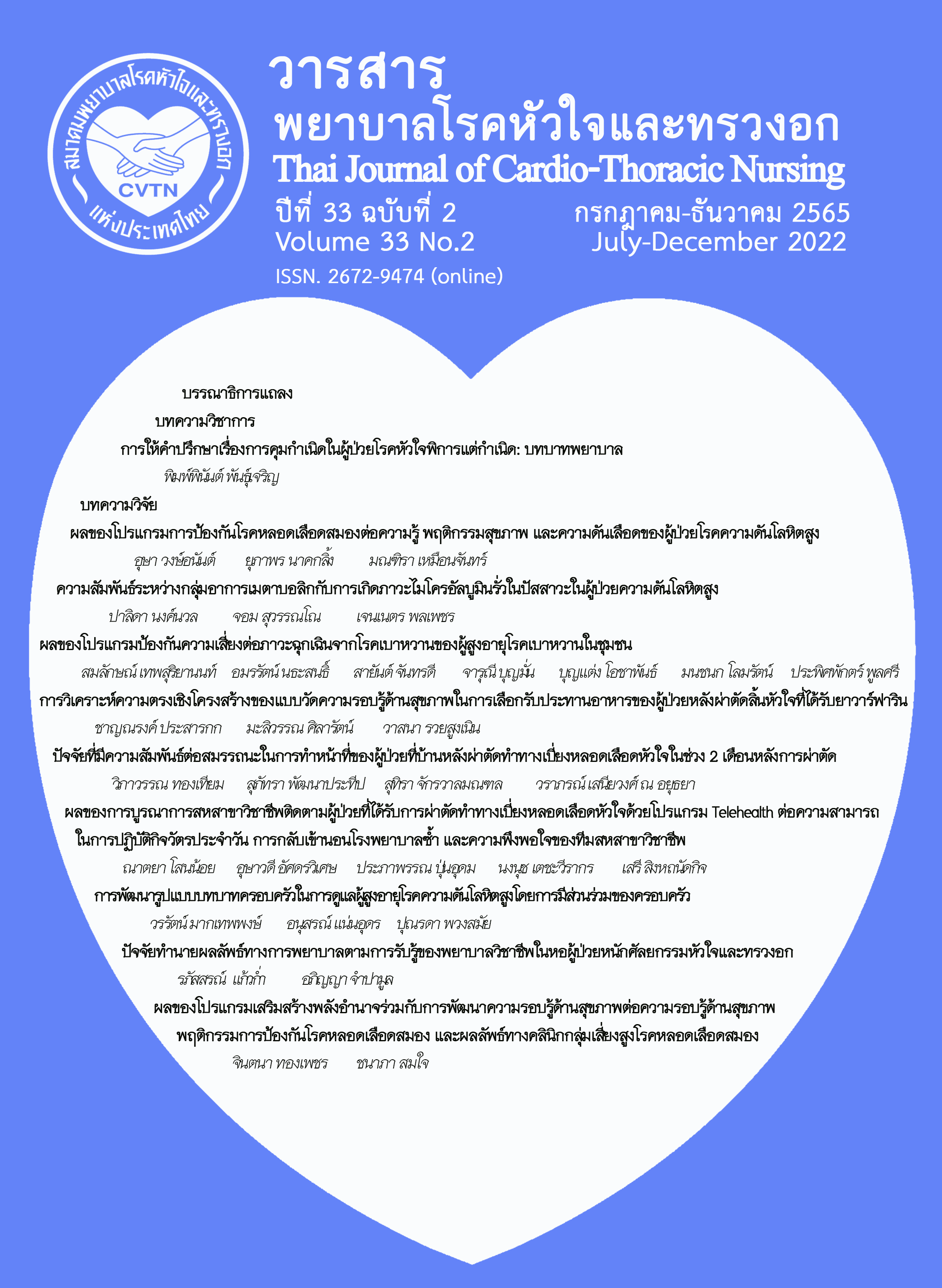ผลของโปรแกรมเสริมสร้างพลังอำนาจร่วมกับการพัฒนาความรอบรู้ด้านสุขภาพต่อความรอบรู้ด้านสุขภาพ พฤติกรรมการป้องกันโรคหลอดเลือดสมอง และผลลัพธ์ทางคลินิกกลุ่มเสี่ยงสูงโรคหลอดเลือดสมอง
คำสำคัญ:
การเสริมสร้างพลังอำนาจ, ความรอบรู้ด้านสุขภาพ, พฤติกรรมการป้องกันโรคหลอดเลือดสมองบทคัดย่อ
การวิจัยเชิงทดลองมีวัตถุประสงค์เพื่อศึกษาผลของโปรแกรมเสริมสร้างพลังอำนาจร่วมกับการพัฒนาความรอบรู้ด้านสุขภาพ กลุ่มตัวอย่างเป็นกลุ่มเสี่ยงสูงโรคหลอดเลือดสมอง 84 คน สุ่มเข้ากลุ่มควบคุมและกลุ่มทดลอง กลุ่มละ 42 คน กลุ่มทดลองได้รับโปรแกรมพัฒนาความรอบรู้ด้านสุขภาพร่วมกับการเสริมสร้างพลังอำนาจ และกลุ่มควบคุมได้รับการพยาบาลตามปกติ เครื่องมือที่ใช้ในการเก็บรวบรวมข้อมูลประกอบด้วยแบบสอบถามความรอบรู้ด้านสุขภาพและพฤติกรรมการป้องกันโรคหลอดเลือดสมอง วิเคราะห์ข้อมูลโดยใช้สถิติเชิงพรรณนาและการทดสอบที
ผลการวิจัยพบว่า หลังเข้าร่วมโปรแกรมเสริมสร้างพลังอำนาจร่วมกับการพัฒนาความรอบรู้ด้านสุขภาพ กลุ่มทดลอง มีค่าเฉลี่ยความดันโลหิตตัวบน ค่าเฉลี่ยความดันโลหิตตัวล่าง ดัชนีมวลกาย ต่ำกว่าก่อนการทดลองและต่ำกว่ากลุ่มควบคุมอย่างมีนัยสำคัญทางสถิติที่ระดับ 0.001 และค่าเฉลี่ยคะแนนความรอบรู้ด้านสุขภาพ พฤติกรรมการป้องกันโรคหลอดเลือดสมอง หลังได้รับโปรแกรม สูงกว่าก่อนการทดลองและสูงกว่ากลุ่มควบคุม อย่างมีนัยสำคัญทางสถิติที่ระดับ 0.001
จากการศึกษา การเสริมสร้างพลังอำนาจและการพัฒนาความรอบรู้ด้านสุขภาพให้กลุ่มเสี่ยงโรคหลอดเลือดสมองในการปรับเปลี่ยนพฤติกรรมสุขภาพ ทำให้เกิดผลลัพธ์ทางคลินิกที่พึงประสงค์ได้ ดังนั้นพยาบาลและบุคลากรทางสุขภาพสามารถนำโปรแกรมนี้ไปใช้ในผู้ป่วยกลุ่มเสี่ยงโรคหลอดเลือดสมอง ส่งเสริมกลุ่มเสี่ยงมีพฤติกรรมการจัดการตนเองที่เหมาะสม เพื่อที่จะลดภาวะเสี่ยงต่อการเกิดภาวะแทรกซ้อนต่อไป
เอกสารอ้างอิง
Lindsay MP, Norrving B, Sacco RL, Brainin M, Hacke W, Martins S, Pandian J, Feigin V. World Stroke Organization (WSO): Global stroke fact sheet 2019. Int J Stroke. 2019 Oct;14(8):806-817. doi: 10.1177/174749 3019881353. PMID: 31658892.
The Policy and Strategy Section, Bureau of Non-Communicable Disease. 5-year national ncds prevention and control strategic and action plan (2017- 2021). 2017. Ministry of Public Health Nonthaburi. [ document on the Internet].2022. [ cited 2022 April 20] Available from: https://www.who.int/docs/default-source /thailand/ncds/national-ncd-prevention-and-control-plan-2017-2021-eng.pdf (in Thai)
Permata EN, Irawati D. The appropriate intervention to improve patient outcome among stroke patients: a literature review. Int J Nurs Stud. 2019;2(2):75-81.
United Nations. Sustainable development goals. [ homepage on the Internet].2022. [ cited 2022 April 20] Available from: https://www.un. org/ sustainabledevelopment/ sustainable-development-goals/.
Nutbeam D. The evolving concept of health literacy. Soc. Sci. Med. 2008; 67(12):2072-8.
Hosseinzadeh N, Ala A, Rahnemayan S, Sadeghi-Hokmabadi E, Milani AG, Asenjan MR, Vahdati SS. Demographic information and risk factors of stroke patients younger than 65 years old. Front. Med. 2022;6(1):e4-e4.
Hirunchunha S, Tubtheing W, Thongtumlueng M, Sureeluangkhajorn O, Balthip K. The empowerment of family and community participation model for health behavioral modification to prevent cerebrovascular disease among at risk group: a case study at Ban Phrao Sub-district, Pa Phayom District, Phatthalung Province. Songklanagarind J Nurs. 2021; 41(1):115-27. (in Thai).
Gibson, C. H.The process of empowerment in mothers chronically ill children. J Adv Nurs. 1995; 21(6): 1201-10.
Faculty of Medicine Ramathibodi Hospital, Mahidol University Cardiovascular and Metabolic Center Ramathibodi Hospital. Thai CV risk sore.2016. [ document on the Internet].2022. [ cited 2022 March 20] Available from: https://med.mahidol.ac.th/ cvmc/thaicv. (in Thai).
Hemrungrojn S, Tangwongchai S, Charoenboon T, Panasawat M, Supasitthumrong T, Chaipresertsud P, Maleevach P, Likitjaroen Y, Phanthumchinda K, Maes M. Use of the Montreal cognitive assessment Thai version to discriminate amnestic mild cognitive impairment from Alzheimer’s disease and healthy controls: machine learning results. Dement Geriatr Cogn. 2021;50(2):183-94.
Sterne JAC, Savovic J, Page MJ, Elbers RG, Blencowe NS, Boutron I, et al. RoB 2: a revised tool for assessing risk of bias in randomised trials. BMJ.2019; 366: l4898.
Clark L, Fairhurst C, Torgerson DJ. Allocation concealment in randomized controlled trials: Are we getting better? BMJ.2016; 355:1–5.
Cohen J..Quantitative methods in psychology: a power primer. Psychol Bull.1992;112 (1): 155-9.
Dwan K, Li T, Altman D G, Elbourne D. CONSORT 2010 statement: extension to randomised crossover trials BMJ. 2019; 366: l4378.
Roma W, Thanasukan C, Thipmongkolkul M, Aimyung N, Nilaprijit N, Somnunklang M, et al. National health literacy survey project for Thai people aged 15 years and above A.D. 2017 (phase 1). Bangkok: Health Systems Research Institute. 2018. (in Thai).
Chen X, Zhao X, Xu F, Guo M, Yang Y, Zhong L, Weng X, Liu X. A systematic review and meta-analysis comparing FAST and BEFAST in acute Stroke patients. Front Neurol. 2022; 28(12):765069.
Slark J, Honey M, Elysabeth Tuty Arna Uly Tarihoran D. Educational strategies for secondary Stroke prevention: an integrative literature review. Am. J Health Educ.2021; 15(1): 1-12.
Walters R, Leslie SJ, Polson R, Cusack T, Gorely T. Establishing the efficacy of interventions to improve health literacy and health behaviours: a systematic review. BMC public health. 2020 ;20(1):1-7.
Edwards Jr DB. Shifting the perspective on community-based management of education: From systems theory to social capital and community empowerment. Int J Educ Dev. 2019; 64 (1):17-26.
Heine M, Lategan F, Erasmus M, Lombaard CM, Mc Carthy N, Olivier J, van Niekerk M, Hanekom S. Health education interventions to promote health literacy in adults with selected non‐communicable diseases living in low‐to‐middle income countries: A systematic review and meta‐analysis. J Eval Clin Pract. 2021;27(6):1417-28.
Thongsuk W, Tipwareerom W, Supametaporn P. Effects of empowerment program on health behaviors, body mass index and blood pressure levels in patients with uncontrolled hypertension. Nurs J. 2020;47(4):229-41.
Lambert CM, Olulana O, Bailey-Davis L, Abedi V, Zand R. “Lessons learned” preventing recurrent ischemic strokes through secondary prevention programs: a systematic review. J Clin Med. 2021;10(18):4209. https://doi.org/10.3390/jcm10184209
Friend ML, Sieloff CL. Empowerment in nursing literature: an update and look to the future. Nurs. Sci. Q. 2018; 31(4):355-61.
Melo P, Alves O. Community empowerment and community partnerships in nursing decision-making. Healthcare. 2019;7(2):76-83.
Pekonen A, Eloranta S, Stolt M, Virolainen P, Leino-Kilpi H. Measuring patient empowerment–a systematic review. Patient Educ. Couns. 2020;103(4):777-87.
Commodore-Mensah Y, Turkson-Ocran RA, Himmelfarb CR. Empowering nurses to lead efforts to reduce cardiovascular disease and stroke risk: tools for global impact. J Cardiovasc Nurs. 2019;34(5):357-60.
Grillo A, Salvi L, Coruzzi P, Salvi P, Parati G. Sodium intake and hypertension. Nutrients. 2019;11(9):1970.
Tomitani N, Kanegae H, Kario K. Self-monitoring of psychological stress-induced blood pressure in daily life using a wearable watch-type oscillometric device in working individuals with hypertension. Hypertens Res. 2022;7(45):1531-1537.
Shi L, Zhang D, Wang L, Zhuang J, Cook R, Chen L. Meditation and blood pressure: a meta-analysis of randomized clinical trials. J. hypertens. 2017; 35(4):696-706.
Hayes P, Ferrara A, Keating A, McKnight K, O'Regan A. Physical activity and hypertension. Rev Cardiovasc Med. 2022;23(9):302.
Holwerda SW, Luehrs RE, DuBose L, Collins MT, Wooldridge NA, Stroud AK, et al. Elevated muscle sympathetic nerve activity contributes to central artery stiffness in young and middle-age/older adults. Hypertens. 2019;73(5):1025-35.
ดาวน์โหลด
เผยแพร่แล้ว
รูปแบบการอ้างอิง
ฉบับ
ประเภทบทความ
สัญญาอนุญาต
ลิขสิทธิ์ (c) 2023 วารสารพยาบาลโรคหัวใจและทรวงอก

อนุญาตภายใต้เงื่อนไข Creative Commons Attribution-NonCommercial-NoDerivatives 4.0 International License.
บทความนี้ยังไม่เคยตีพิมพ์หรืออยู่ในระหว่างส่งไปตีพิมพ์ในวารสารอื่น ๆ มาก่อน และกองบรรณาธิการขอสงวนสิทธิ์ในการตรวจทาน และแก้ไขต้นฉบับตามเกณฑ์ของวารสาร ในกรณีที่เรื่องของท่านได้ได้รับการตีพิมพ์ในวารสารฉบับนี้ถือว่าเป็น ลิขสิทธิ์ของวารสารพยาบาลโรคหัวใจและทรวงอก






